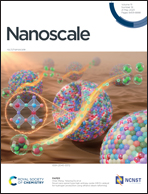Molecular design of a highly matched and bonded interface achieves enhanced thermal boundary conductance†
Abstract
Interfacial binding and phonon mismatch are two crucial parameters in determining thermal boundary conductance. However, it is difficult for polymer/metal interfaces to possess both significant interfacial binding and weak phonon mismatch to achieve enhanced thermal boundary conductance. Herein, we circumvent this inherent trade-off by synthesizing a polyurethane and thioctic acid (PU-TA) copolymer with multiple hydrogen bonds and dynamic disulfide bonds. Using PU-TA/aluminum (Al) as a model interface, we demonstrate that the thermal boundary conductance of the PU-TA/Al interfaces measured by transient thermoreflectance is 2–5 times higher than that of traditional polymer/Al interfaces, which is attributed to the highly matched and bonded interface. Furthermore, a correlation analysis is developed, which demonstrates that interfacial binding has a greater impact than phonon mismatch on thermal boundary conductance at a highly matched interface. This work provides a systematic understanding of the relative contributions of the two dominant mechanisms to thermal boundary conductance by tailoring the polymer structure, which has applications in thermal management materials.



 Please wait while we load your content...
Please wait while we load your content...